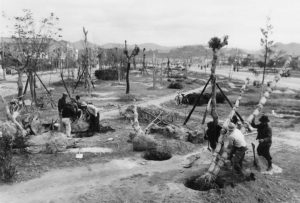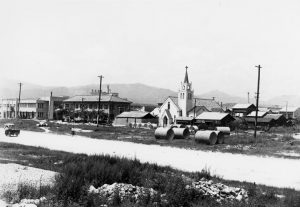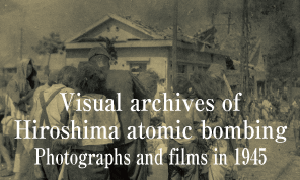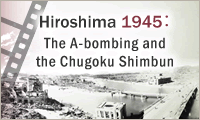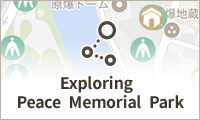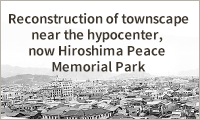Documenting Hiroshima 80 years after A-bombing: In November 1957, tree-planting campaign begins along Peace Boulevard
Mar. 26, 2025
In start to restoration of greenery in city, 6,000 trees planted
by Minami Yamashita, Staff Writer
In November 1957, the Hiroshima City government began its full-scale planting of trees along Peace Boulevard, which runs east and west in the central area of the city. That effort was part of a tree-planting campaign that called for tree donations from different parts of Hiroshima Prefecture. Designed as a way to also enhance disaster-prevention and tourism in Hiroshima, the tree-planting campaign was conducted through 1958 to turn the boulevard, measuring 100 meters wide and ultimately around four kilometers in length, into a relaxing green space based on widespread calls for cooperation.
During the war, the entire area was subject to building demolition targeting houses and buildings to prevent the spread of fires at times of air raids. When the U.S. military dropped the atomic bomb on Hiroshima, many people had been mobilized from schools and other areas in the city to engage in demolition-work there, resulting in the loss of many lives in the atomic bombing with no structures to serve as protection.
Love of greenery
In 1946, the year after the end of the war, Hiroshima City compiled a city reconstruction plan, coming up with the idea of constructing a “100-meter-wide road” in the area. In November, work to level ground for the road started in the area around Komachi (in Hiroshima’s present-day Naka Ward), with the boulevard being extended gradually over time. In 1951, the avenue was named Peace Boulevard based on naming proposals submitted by the public. Two bridges—Peace Bridge and West Peace Bridge, for which the sculptor Isamu Noguchi designed the handrails—were built across Motoyasu River and Honkawa River, two rivers running on the east and the west sides of Peace Memorial Park, and a bronze statue of a nude woman was also erected on the boulevard. With that activity, the work of creating a greenspace was delayed.
Kazuo Imanishi, 84, a resident of the city’s Naka Ward and former general manager of Sanfrecce Hiroshima, a professional Hiroshima-based soccer team, shared his recollections of the boulevard. “Back then, I only had the impression that the road was wide. With only some wooded areas at the bottom of Hijiyama Hill, we were starved for greenery,” said Mr. Imanishi. When a fourth-year elementary school student, he returned to the area of Hiratsuka-cho (in the city’s present-day Naka Ward), where his family had lived before the bombing. Peace Boulevard happened to be located directly in front of his home.
Some people were doubtful about the city’s plan of developing the boulevard, with its unprecedented nature, given Hiroshima’s status as merely a city of regional scope. In the city’s mayoral election of 1955, Tadao Watanabe was elected for the first time, beating incumbent mayor Shinso Hamai and other candidates, by pledging to reduce the road width by half for the aim of constructing municipal housing. Nevertheless, Mr. Watanabe changed his mind after taking office and ended up supporting the tree-planting campaign after being persuaded by those around him.
Trees also planted near Hiroshima Prefectural Girls’ High School monument
Boasting the catch copy “Dreaming of Hiroshima in 20 years,” a marketing poster to promote the tree-planting campaign called for broad cooperation from individuals and groups with the wording, “An offering for those who died in the extremely tragic situation 12 years ago.” According to the Chugoku Shimbun published on April 23, 1957, Tsuneko Kurisu, from the town of Kake (in Hiroshima Prefecture’s present day Akiota town), donated oak and Japanese zelkova trees to the campaign. Ms. Kurisu had lost her daughter, Motoko, 12 at the time and a first-year student at First Hiroshima Prefectural Girls’ High School (present-day Minami High School), in the atomic bombing.
First-year students at the school had been mobilized for the work of tearing down buildings in the Dobashi district (in Hiroshima’s present-day Naka Ward), located around 800 meters from the hypocenter. All 223 students who had been at the work site perished in the atomic bombing. Based on Ms. Kurisu’s request, the trees she donated were planted next to the monument memorializing the prefectural girls’ school students, erected in 1955, situated along Peace Boulevard.
According to the city government, around 6,000 trees were donated by individuals and organizations in 1957 and 1958, marking the start to restoration of greenery in the city. Half of the trees came from the district of Yamagata-gun, with key tree species being camphor, maple, and Japanese zelkova. Some of the original trees are thought to still remain on the boulevard to this day. In May 1965, Peace Boulevard was completed, running from the east end of Tsurumi Bridge (in the city’s present-day Minami Ward) to the west end of the new Koi Bridge (in Nishi Ward).
(Originally published on March 26, 2025)

